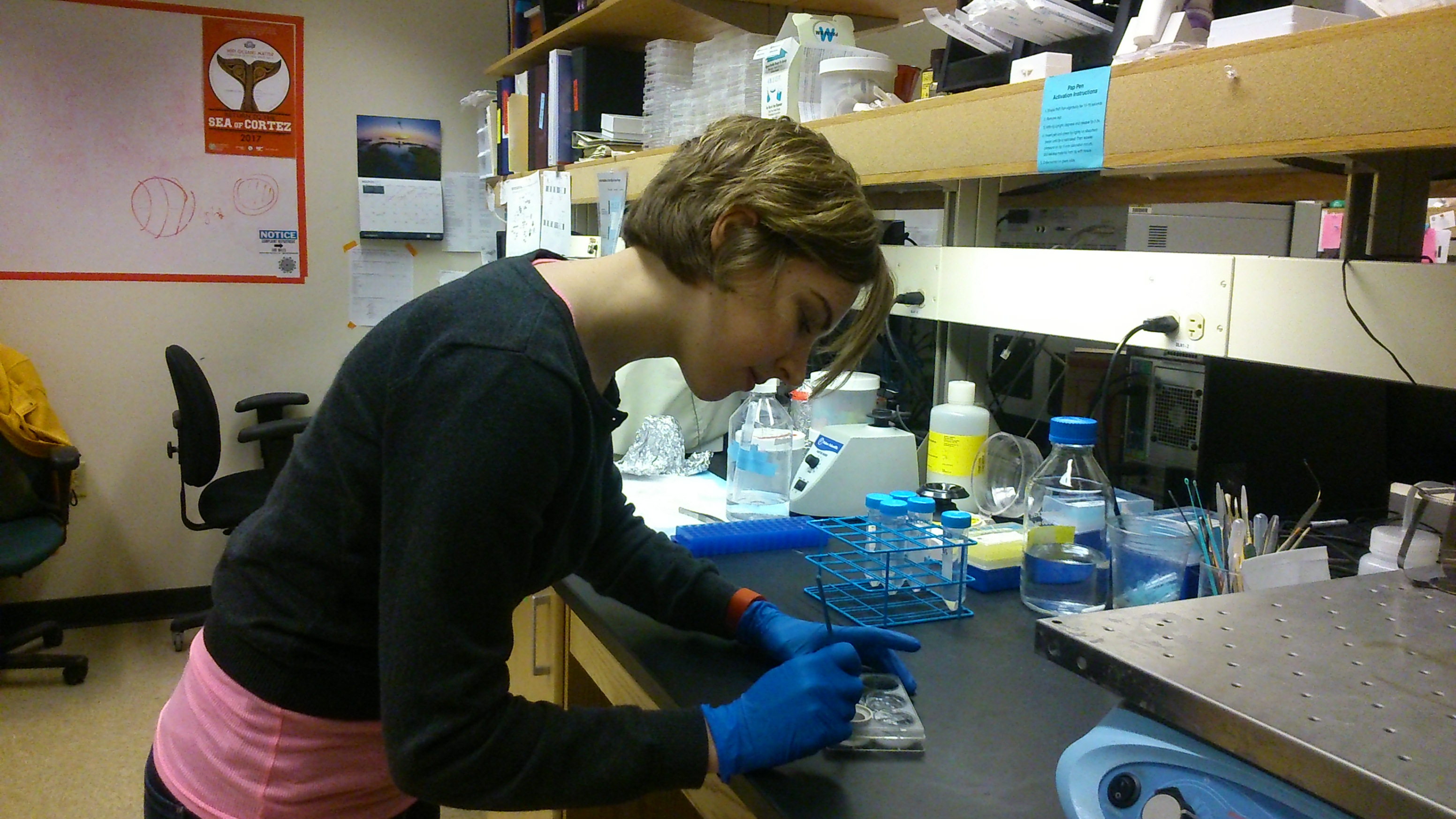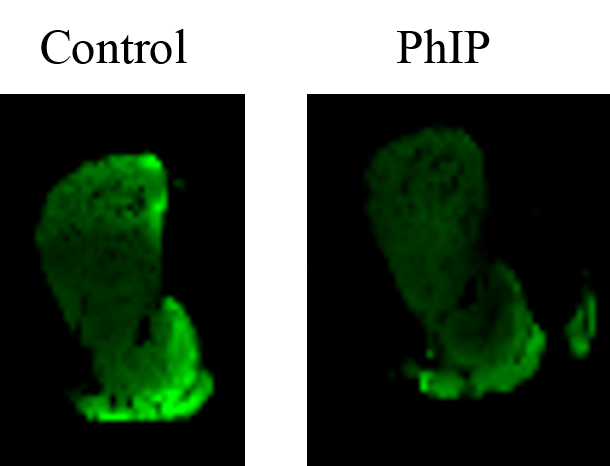Rachel Foguth

Life Sciences
Mentor / Lab:
Jason Cannon
Specific Research Area / Project:
Heterocyclic Amine Exposure and Risk of Parkinson's Disease
Undergraduate Institution:
Benedictine College
Research Profile:
Parkinson's disease (PD) is the second most common neurodegenerative disease. Much research has been done on genetic mutations that lead to PD; however, less than ten percent of cases are known to be caused by genetic factors. Therefore, research has started focusing on gene-environment interactions, where a genetic component would make a person more prone to the disease, and an environmental exposure tips the scale, leading to disease onset. My research is focusing on a class of chemicals, called heterocyclic amines, which are present in the diet, especially in things like overcooked or charred meat, coffee, tobacco products, and certain types of alcohol. Our lab has previous research that has shown these compounds are toxic specifically to dopaminergic neurons, those affected in PD, in primary midbrain cultures. Therefore, I am using in vivo and in vitro methods to determine whether these compounds can cause Parkinsonian-type motor deficits and pathology in animals, such as lesions in the substantia nigra, decreased axonal projections from dopaminergic neurons from the substantia nigra, and changes in dopamine levels or dopamine metabolism.
Besides determining if these chemicals can produce Parkinson’s disease models, I am also using in vitro research to elucidate the mechanism of toxicity of these compounds. Because they are structurally very similar to MPTP, a contaminant of street drugs that is known to cause Parkinson’s disease through inhibition of mitochondrial complex I, I hypothesized, that mitochondrial dysfunction is occurring. Determining the mechanism of toxicity of these compounds could reveal pathways for potential therapeutic targets to combat PD.
About Me:

As I was growing up, I was constantly being exposed to science because my father is a chemical engineer. We would make peanut brittle every year, a family tradition, and even that included a science lesson on how the baking soda reacts with the peanut brittle to make it nice and foamy. Therefore, I always knew I wanted to be a scientist; however, I was unsure what I wanted to study. During my undergraduate career, I had the opportunity to work in a neurotoxicology lab one summer, and I immediately fell in love with the complexity of the brain and how much could go wrong, leading to various neurological diseases. When I applied for graduate school, I knew I wanted to continue studying neurological diseases, but was unsure what aspect I wanted to study it from, whether it be toxicology, pharmacology, or more basic medical sciences. This lead me to finding the PULSe program at Purdue, which gave me a year of rotations where I could work in labs I found interesting and determine what area of neurobiology I wanted to join before I committed to it. When I interviewed with Dr. Cannon, I was immediately drawn to the research being done in his laboratory because it was something I could see myself doing and leading me to my goals of helping the people with neurodegenerative diseases. However, I still have found great resources in other laboratories I rotated in, working closely with Dr. Rochet’s lab in particular. The rotations also lead to me meeting many people I wouldn’t necessarily have worked with, which gives me a large network of colleagues to turn to when I am starting research that is outside of my skill set.
Awards:
- Women in Science Travel Grant, 2017
- Compton Graduate Research Travel Award, College of Health and Human Sciences, 2017
- Outstanding Senior Biochemistry/Chemistry Major Award, Benedictine College, ACS Wakarusa Valley Section, Spring 2015
- 1st Place in American Chemical Society Wakarusa Chapter Local Oral Presentation, Benedictine College, Fall 2014
- Department of Toxicology Undergraduate Research Award, University of Texas Medical Branch, Summer 2013
Publications:
- Hernandez-Franco, P., Anandhan, A., Foguth, R., Franco, R. (2017)“Oxidative Stress and Redox Signalling in the Parkinson's Disease Brain.” Oxidative Stress and Redox Signalling in Parkinson's Disease. Royal Society of Chemistry.
Presentations:
- Foguth, R., Agim, Z. S., Cannon, J. (2018), Heterocyclic Amine-Induced Bioenergetics Alterations. Purdue Office for Interdisciplinary Graduate Programs Spring Reception, West Lafayette, IN.
- Foguth, R., Agim, Z. S., Cannon, J. (2018), Heterocyclic Amine-Induced Bioenergetics Alterations. Ohio Valley Society of Toxicology Graduate Summer Meeting, West Lafayette, IN.
- Foguth, R., Agim, Z. S., Cannon, J. (2018), Heterocyclic Amine-Induced Alterations in Neuronal Bioenergetics. Indiana Society for Neuroscience Meeting, West Lafayette, IN.
- Foguth, R., Agim, Z. S., Cannon, J. (2018), Heterocyclic Amine-Induced Bioenergetics Alterations. National Society of Toxicology Meeting, San Antonio, TX.
- Foguth, R., Agim, Z. S., Cannon, J. (2018), Heterocyclic Amine-Induced Bioenergetics Alterations. Ohio Valley Society of Toxicology Meeting, West Lafayette, IN.
- Foguth, R., Cannon, J. (2017) Characterization of a Potential Model for Parkinson's Disease: PhIP Exposure in Mouse. Purdue Institute for Integrated Neuroscience Retreat, St. Joseph, MI.
- Foguth, R., Schramp, M. (2015) The Use of PCR and Gel Electrophoresis in Looking at Epithelial Cell Morphogenesis in C. elegans. Benedictine College Discovery Day, Atchison, KS.
- Foguth, R., Anandhan, A., Franco-Cruz, R. (2014) Dopaminergic Cell Death Induced By Manganese and Alpha-Synuclein: Oxidative Stress, p38, and Nuclear Factor-Kappa B Signaling. Wakarusa Valley American Chemical Society Student Research Symposium, Atchison, KS.
- Foguth, R., Anandhan, A., Franco-Cruz, R. (2014) Dopaminergic Cell Death Induced By Manganese and Alpha-Synuclein: Oxidative Stress, p38, and Nuclear Factor-Kappa B Signaling. University of Nebraska-Lincoln Summer Undergraduate Research Program Symposium, Lincoln, NE.
- Foguth, R., Nickel, N., Denton, M., Schramp, M. (2014) Observing the Genetic Interactions of TES-1 and UNC-34 in Vulval Development of C. elegans. Benedictine College Discovery Day, Atchison, KS.
- Foguth, R., Schramp, M. (2013), Effects of TES-1 and UNC-34 proteins on the Behavior of Epithelial Cells. Benedictine College Discovery Day, Atchison, KS.
Leadership:
- Health Sciences Graduate Student Organization, Vice-President
- Science in Schools Science Day/Night, Volunteer
- PULSe First Year Mentoring Program, Participant
- Purdue Women in Science, Participant

